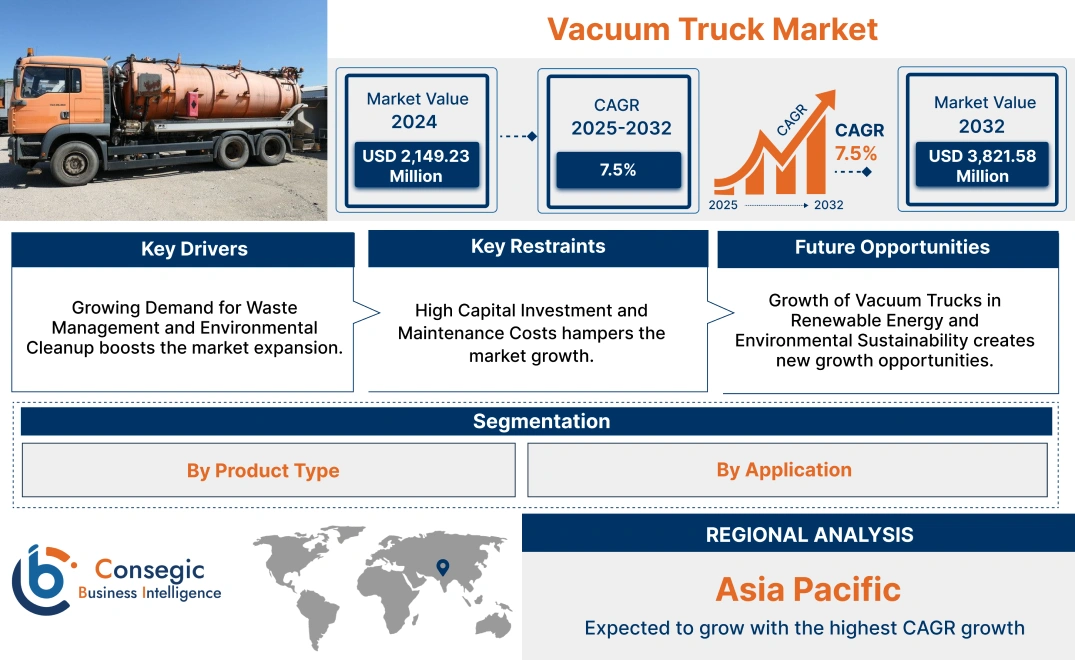- Summary
- Table Of Content
- Methodology
Vacuum Truck Market Size:
Vacuum Truck Market size is estimated to reach over USD 3,821.58 Million by 2032 from a value of USD 2,149.23 Million in 2024 and is projected to grow by USD 2,271.27 Million in 2025, growing at a CAGR of 7.50% from 2025 to 2032.
Vacuum Truck Market Scope & Overview:
A vacuum truck, also known as a vacuum tanker, is a vehicle equipped with a pump and tank designed to collect, transport, and dispose of liquids, slurries, and sludge from various environments. These trucks create a vacuum to draw materials into the holding tank, making them essential for a wide range of applications, including septic tank maintenance, industrial cleaning, waste management, and hazardous material handling. Vacuum trucks play a critical role in ensuring proper sanitation, environmental protection, and industrial efficiency by enabling safe and efficient waste removal.
Vacuum trucks are used in diverse industries such as municipal services, construction, oil and gas, and industrial cleaning. The vehicles come in various configurations depending on their intended use, with some designed for liquid waste collection and others for handling hazardous materials or heavy sludge. Their durability, efficiency, and ability to handle both routine and emergency operations make them indispensable for maintaining clean and safe work environments.
End-users of vacuum trucks include municipalities, construction firms, industrial facilities, and waste management companies. As regulations around waste disposal and environmental protection tighten, the demand for advanced and efficient vacuum trucks continues to grow, driving the market forward and enhancing waste management operations.
Vacuum Truck Market Dynamics - (DRO) :
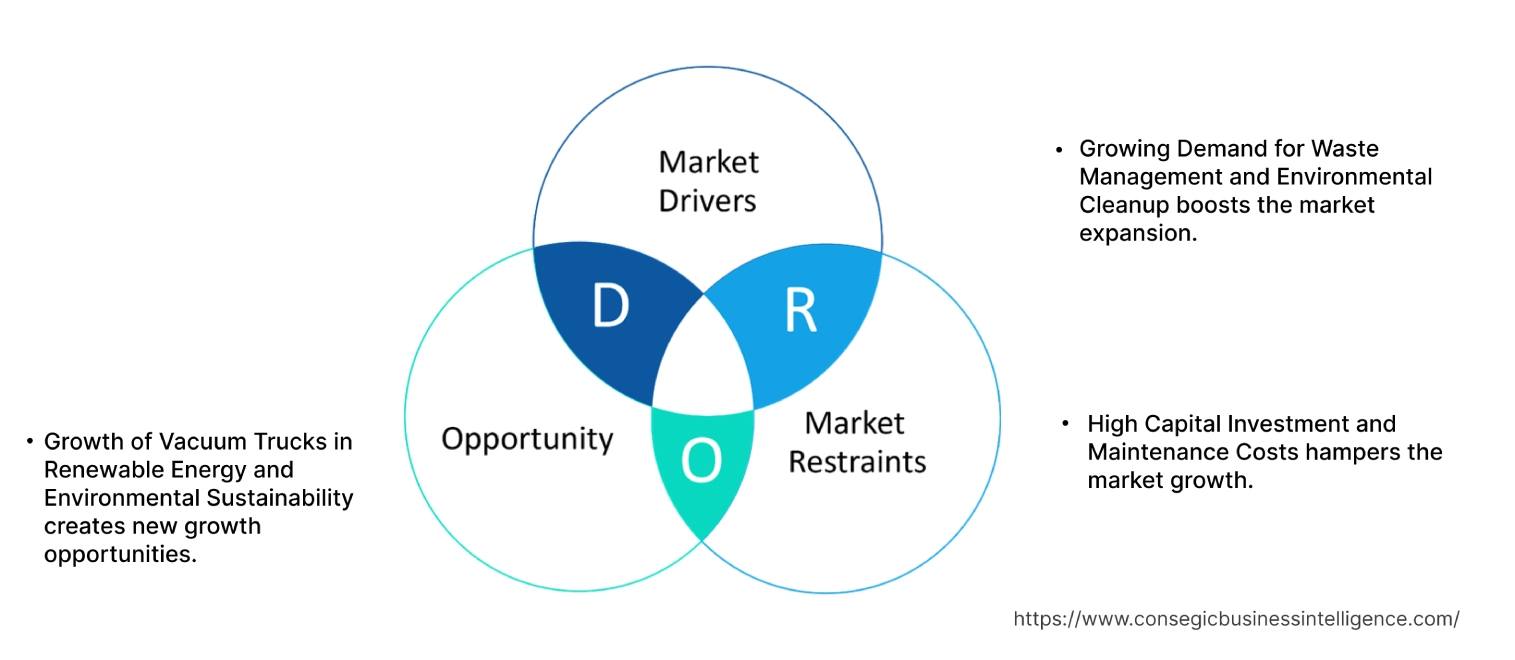
Key Drivers:
Growing Demand for Waste Management and Environmental Cleanup boosts the market expansion.
The rising emphasis on waste management and environmental cleanup is a significant driver for the vacuum truck market. Increasing urbanization and industrialization have resulted in a growing need for efficient waste collection, transportation, and disposal solutions, particularly in sectors such as municipal waste management, construction, oil & gas, and industrial cleaning. Vacuum trucks play a critical role in collecting and transporting hazardous materials, liquid waste, sewage, and sludge, ensuring proper disposal and compliance with environmental regulations. Governments and municipalities are investing heavily in sustainable waste management solutions to minimize environmental impact, which has led to increased demand for advanced vacuum trucks with greater capacity and efficiency. Moreover, the rise of industrial cleaning services for maintaining factory and refinery cleanliness is fueling the vacuum truck market growth.
Key Restraints :
High Capital Investment and Maintenance Costs hampers the market growth.
The high capital investment required to purchase vacuum trucks, coupled with the ongoing maintenance costs, is a major challenge for many companies, particularly small and medium-sized enterprises (SMEs). Vacuum trucks, especially those with specialized features such as high-capacity tanks, hydro-excavation systems, and advanced filtration technologies, involve significant upfront costs. Additionally, these trucks require regular maintenance to ensure optimal performance, which adds to the overall operational expenses. Replacement parts, engine repairs, and tank cleaning further contribute to high maintenance costs, which deter smaller businesses from investing in vacuum trucks. The need for skilled operators and technicians to manage these complex vehicles also increases training costs, limiting adoption among companies with tight budgets. As a result, the high cost of ownership hinders the vacuum truck market demand.
Future Opportunities :
Growth of Vacuum Trucks in Renewable Energy and Environmental Sustainability creates new growth opportunities.
The expanding focus on renewable energy and environmental sustainability presents a significant opportunity for the market. As industries such as solar energy, wind power, and bioenergy continue to grow, the need for environmental cleaning services and waste management solutions will increase. Vacuum trucks are essential for maintaining clean energy plants, cleaning cooling systems, and removing sludge and waste materials generated during the production of renewable energy. Moreover, the rising adoption of vacuum trucks in environmental remediation projects, such as soil decontamination and groundwater treatment, is driving demand for eco-friendly vacuum truck solutions equipped with low-emission engines and sustainable waste disposal technologies. Companies that focus on developing green vacuum trucks and energy-efficient vehicles will be well-positioned to capture the growing demand from industries seeking to reduce their carbon footprint and comply with stricter environmental regulations. Therefore, this growing emphasis on sustainability drives the vacuum truck market opportunities.
Vacuum Truck Market Segmental Analysis :
By Product Type:
Based on product type, the vacuum truck market is segmented into liquid vacuum trucks, dry vacuum trucks, and combination vacuum trucks.
The liquid vacuum trucks segment accounted for the largest revenue of 61.28% the total vacuum truck market share in 2024.
- Liquid vacuum trucks are primarily used for collecting and transporting hazardous and non-hazardous liquids, slurries, and other fluid waste materials, making them essential for industries such as oil and gas, wastewater management, and industrial cleaning.
- These trucks are equipped with strong vacuum pumps that can handle large volumes of liquid waste, and their versatility in different industries makes them the dominant product type in the market.
- Increasing environmental regulations and the need for efficient waste management in industries are driving demand for liquid vacuum trucks.
- Therefore, as per vacuum truck market trends, liquid vacuum trucks hold the largest share, driven by their widespread application in various industries and their ability to manage hazardous liquids.
The combination vacuum trucks segment is anticipated to register the fastest CAGR during the forecast period.
- Combination vacuum trucks are gaining popularity due to their ability to handle both liquid and dry materials, making them versatile for multiple applications such as sewer cleaning, industrial waste management, and hazardous material cleanup.
- These trucks can efficiently switch between liquid and dry vacuuming, offering cost savings and improved operational efficiency for businesses that require a multi-functional vacuum solution.
- The increasing demand for flexible and efficient vacuum trucks across different industries, particularly in urban sanitation and infrastructure maintenance, is driving the growth of the combination vacuum trucks segment.
- As per vacuum truck market analysis, the versatility of combination vacuum trucks makes them an increasingly popular choice for industries looking for cost-effective, multi-purpose vacuum solutions.
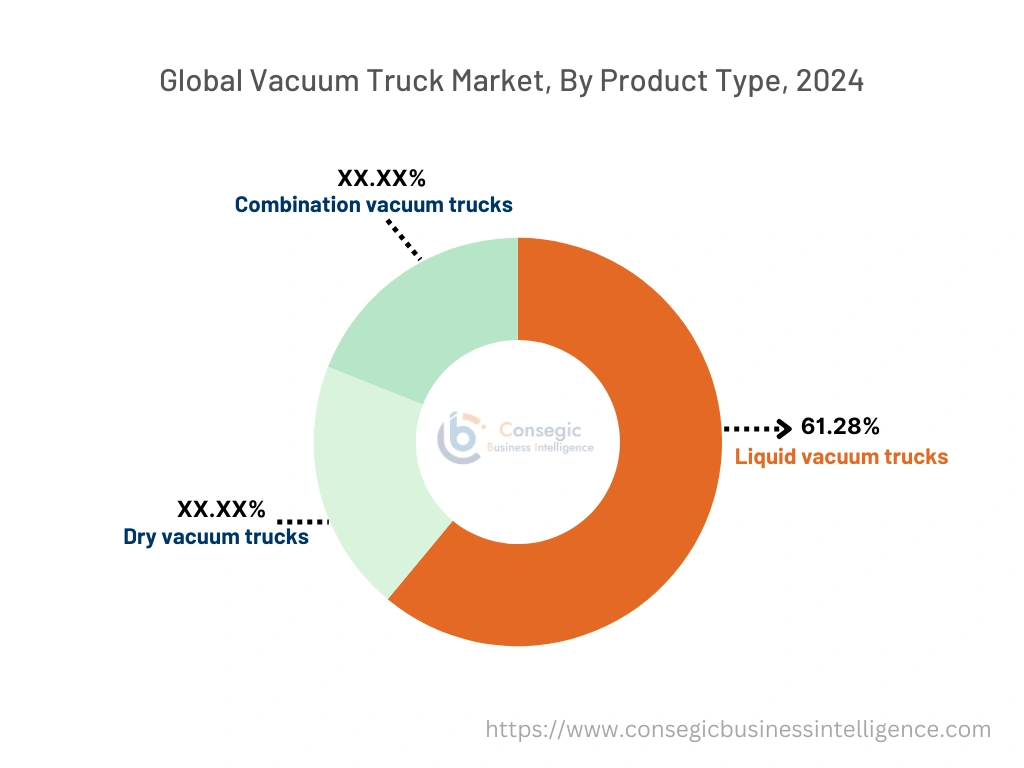
By Application:
Based on application, the vacuum truck market is segmented into industrial, municipal, commercial, and others.
The municipal segment accounted for the largest revenue share in 2024.
- Municipal applications for vacuum trucks include sewer and drain cleaning, maintenance of water systems, and wastewater management, making municipalities the largest consumer of vacuum trucks globally.
- The demand for vacuum trucks in municipalities is driven by the need for regular maintenance of sewage systems, flood cleanup, and urban waste management services, particularly in developed regions.
- The growth of urban areas and the increasing focus on improving public health and sanitation infrastructure have further boosted demand for vacuum trucks in municipal applications.
- As per segmental trends analysis the municipal segment fuels the vacuum truck market growth, driven by the ongoing maintenance of public infrastructure and wastewater management systems in urban and suburban regions.
The industrial segment is anticipated to register the fastest CAGR during the forecast period.
- Vacuum trucks are essential in industries such as petrochemicals, power plants, manufacturing, and mining for the collection and disposal of hazardous materials, including liquid waste, slurries, and dry debris.
- The increasing focus on environmental regulations and the need for efficient industrial waste management are driving the demand for vacuum trucks in industrial applications.
- Additionally, industries that require routine maintenance of large tanks, pipes, and reactors are adopting vacuum trucks to ensure compliance with safety and environmental standards.
- As per segmental trends analysis, the rising need for hazardous material handling and industrial waste management boosts the vacuum truck market expansion in industrial applications.
Regional Analysis:
The regions covered are North America, Europe, Asia Pacific, the Middle East and Africa, and Latin America.
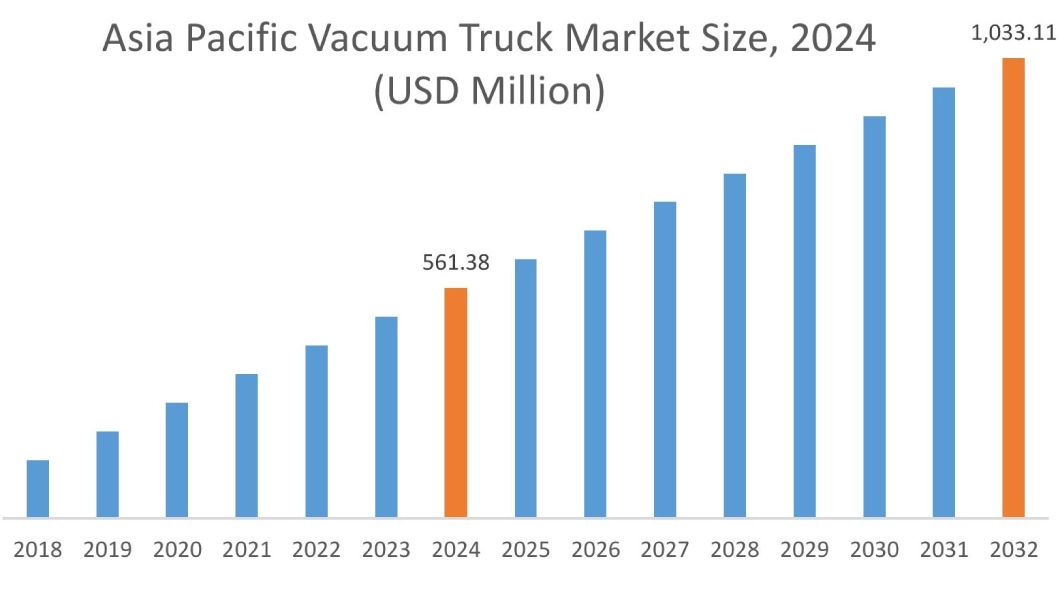
Asia Pacific region was valued at USD 632.97 Million in 2024. Moreover, it is projected to grow by USD 670.8 Million in 2025 and reach over USD 1,163.67 Million by 2032. Out of these, China accounted for the largest share of 30.3% in 2024. The Asia-Pacific region is witnessing rapid development in the vacuum truck market, driven by increasing urbanization, expanding industrial activities, and the need for efficient waste management solutions. China leads the market, with strong demand across municipal cleaning, sewage management, and industrial sectors. The country's aggressive urbanization and focus on environmental protection are spurring investments in advanced vacuum trucks for sewage treatment and hazardous waste disposal. India is also a fast-growing market, where vacuum trucks are being increasingly used for sanitation improvements and municipal solid waste management in urban areas. The government's initiatives like the Swachh Bharat Mission (Clean India Mission) are driving the demand for modern waste management vehicles, including vacuum trucks. In Japan and South Korea, demand is growing due to the need for industrial cleaning in sectors like automotive and electronics manufacturing.
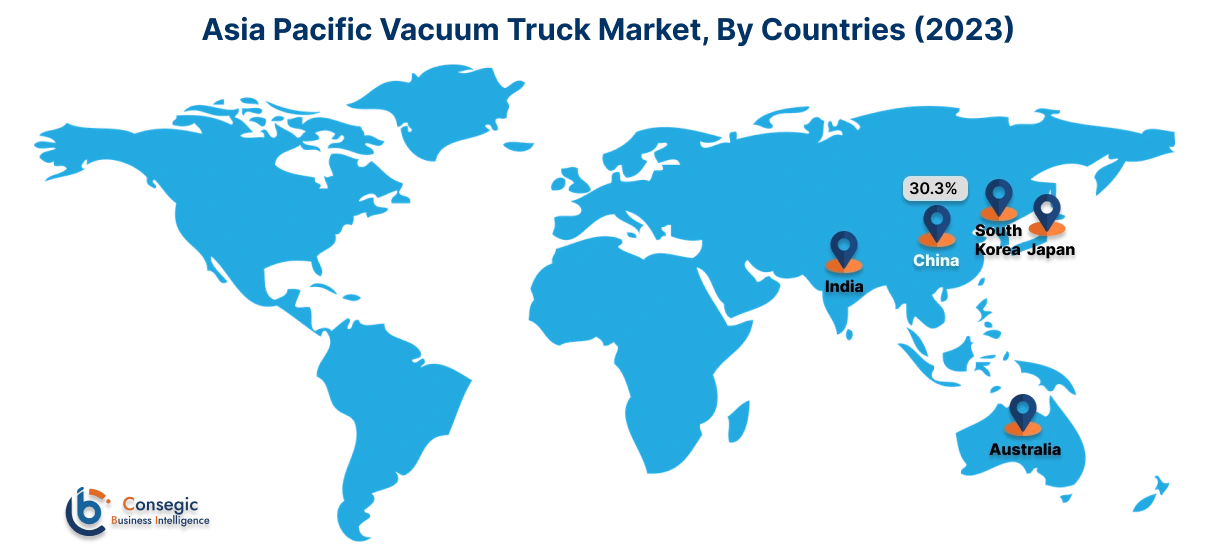
North America is estimated to reach over USD 1,238.57 Million by 2032 from a value of USD 712.92 Million in 2024 and is projected to grow by USD 751.96 Million in 2025. North America is one of the largest markets for vacuum trucks, driven by the growing need for waste management, industrial cleaning, and sewage disposal services. The United States leads the region, with strong demand in sectors such as municipal services, oil and gas, and construction. The presence of stringent regulations, such as the Clean Water Act and EPA (Environmental Protection Agency) standards, has accelerated the adoption of advanced vacuum trucks for proper waste handling and disposal. In addition to environmental regulations, increasing investments in infrastructure development projects across the U.S. further propel market growth. Canada also plays a significant role, particularly in the oil sands industry, where vacuum trucks are used for drilling mud removal and industrial spill cleanups.
Europe represents a key market for vacuum trucks, especially in countries such as Germany, France, Italy, and the UK. The region's focus on environmental sustainability and waste management efficiency drives significant demand for vacuum trucks, particularly for use in urban sanitation, municipal cleaning, and industrial applications. Germany, with its strong emphasis on green technology and clean infrastructure, is a leading adopter of eco-friendly vacuum trucks equipped with electric or hybrid engines to reduce emissions. France and Italy are seeing growing demand in sewage management and urban infrastructure maintenance, where vacuum trucks are employed for cleaning and maintenance of drainage systems and construction sites. The UK has increased investments in industrial waste disposal and flood management systems, where vacuum trucks play a crucial role.
The Middle East and Africa (MEA) region is seeing growing demand for vacuum trucks, particularly in countries like UAE, Saudi Arabia, and South Africa. The oil and gas industry in the Middle East is a key driver for the vacuum truck market, where these vehicles are essential for cleaning drilling sites, oil spill management, and hazardous waste removal. Saudi Arabia and the UAE have also been investing in urban infrastructure development and waste management solutions, particularly in their rapidly growing cities, which fuels demand for vacuum trucks. In South Africa, the growth of municipal cleaning and industrial waste disposal services is contributing to the market, especially in urban centers.
Latin America is an emerging market for vacuum trucks, with growth driven by countries such as Brazil, Mexico, and Argentina. In Brazil, the demand for vacuum trucks is largely driven by the need for sewage management and wastewater treatment in both urban and rural areas. The government's focus on improving sanitation infrastructure is a significant factor, as aging sewage systems require regular cleaning and maintenance. Mexico is another key market, where the growth of construction and oil and gas industries is fueling the need for vacuum trucks to handle industrial spills, drilling operations, and construction site cleaning. In Argentina, vacuum trucks are increasingly used in agricultural waste management and municipal cleaning services.
Top Key Players & Market Share Insights:
The vacuum truck market is highly competitive with major players providing vacuum truck services to the national and international markets. Key players are adopting several strategies in research and development (R&D), product innovation, and end-user launches to hold a strong position in the global vacuum truck market. Key players in the vacuum truck industry include -
- Federal Signal Corporation (USA)
- Vac-Con, Inc. (USA)
- Cappellotto S.p.A. (Italy)
- Keith Huber Corporation (USA)
- Super Products LLC (USA)
- Sewer Equipment (USA)
- Guzzler Manufacturing, Inc. (USA)
- Ledwell & Sons (USA)
- KOKS Group (Netherlands)
- Foton Motor Group (China)
Recent Industry Developments :
Product Enhancement:
- In September 2023, The Vermeer VXT600 vacuum truck has undergone a complete redesign to enhance its performance and provide a lightweight machine that allows for a high spoil tank capacity. With a spoil tank capacity of 12 cubic yards and a freshwater tank of 1,200 gallons, it remains the lightest vacuum excavator in its class. Key upgrades include a powerful vacuum system, a low-profile design for better maneuverability, and an optional tank vibrator for efficient cleanouts. The model is available with chassis options from Kenworth and Mack, optimized for utility contractors looking for high productivity.
Investments & Acquisitions:
- In March 2024, Blue Planet acquired Vac-Tech Engineering, which includes integrating Vac-Tech's fleet of vacuum trucks, which are essential for hazardous waste removal and management. These trucks play a crucial role in safely transporting and disposing of hazardous materials, supporting Blue Planet's goal of advancing innovation in sustainable waste solutions. This acquisition will enhance their offerings in industrial services, including dewatering and complex waste management, helping reduce the environmental impact and improving operational efficiency.
Vacuum Truck Market Report Insights :
| Report Attributes | Report Details |
| Study Timeline | 2019-2032 |
| Market Size in 2032 | USD 3,821.58 Million |
| CAGR (2025-2032) | 7.5% |
| By Product Type |
|
| By Application |
|
| By Region |
|
| Key Players |
|
| North America | U.S. Canada Mexico |
| Europe | U.K. Germany France Spain Italy Russia Benelux Rest of Europe |
| APAC | China South Korea Japan India Australia ASEAN Rest of Asia-Pacific |
| Middle East and Africa | GCC Turkey South Africa Rest of MEA |
| LATAM | Brazil Argentina Chile Rest of LATAM |
| Report Coverage |
|
